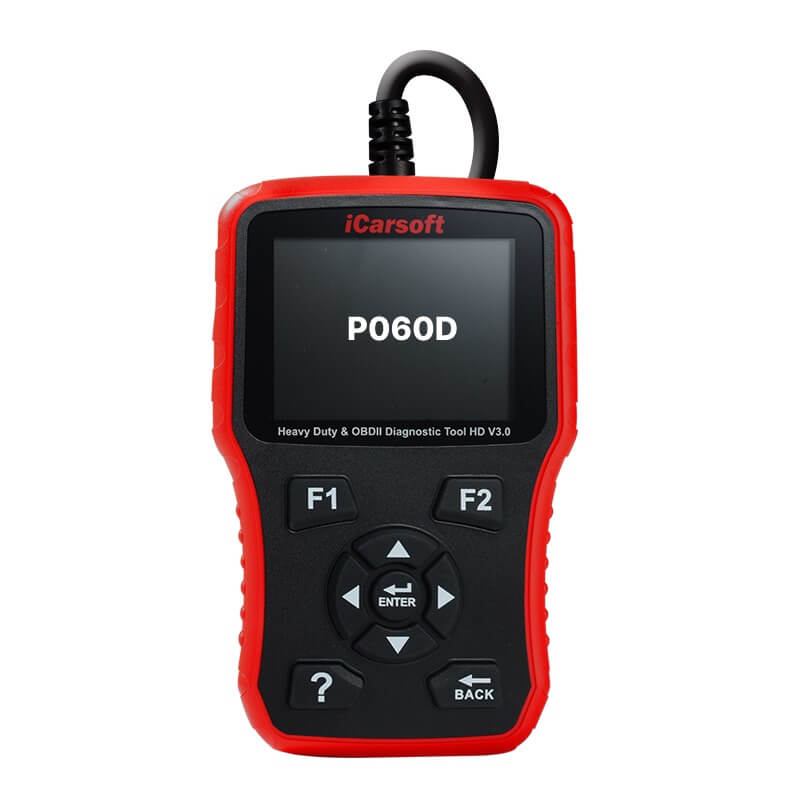P060D – Control Module Performance
POSTED IN pcodes
Are you experiencing issues with your engine control module performance? The P060D trouble code may be the culprit. In this article, we will explore the technical description, meaning, severity, symptoms, common causes, troubleshooting steps, and repair solutions for control module performance issues.
The P060D code specifically refers to an internal performance error with the accelerator pedal position (APP) sensor circuit in the powertrain control module (PCM). If your vehicle has a drive-by-wire throttle system, this code may be accompanied by other internal PCM performance errors.
Some common symptoms of the P060D code include multiple drivability issues, harsh or erratic automatic transmission shifting, reduction in fuel efficiency, rough idle or stall, hesitation upon acceleration, limited or no acceleration, stuck throttle, and inoperative cruise control.
The code can be caused by a variety of factors, including a faulty controller or programming error, open or shorted circuits or connectors in the CAN harness, insufficient control module ground, defective TPS or APP sensor, corroded electrical connectors, open or shorted circuits between the TPS/APP sensor and the PCM, and a faulty DBW actuator motor. Diagnosing the specific cause of the code may require the use of a diagnostic scanner, DVOM, and vehicle information source.
Repairing the P060D code may involve correcting a programming error, replacing faulty components such as the controller or sensor, or reprogramming the PCM. It is important to address the code promptly to prevent further damage to your vehicle and ensure safe operation.
Buy tested tuning file for Adblue / EGR / DPF / Adblue off now!
Key Takeaways:
- The P060D code indicates an internal performance error with the accelerator pedal position (APP) sensor circuit in the powertrain control module (PCM).
- Symptoms of the code can include multiple drivability issues, harsh or erratic automatic transmission shifting, reduction in fuel efficiency, rough idle or stall, hesitation upon acceleration, limited or no acceleration, stuck throttle, and inoperative cruise control.
- Common causes of the P060D code include a faulty controller or programming error, open or shorted circuits or connectors in the CAN harness, insufficient control module ground, defective TPS or APP sensor, corroded electrical connectors, open or shorted circuits between the TPS/APP sensor and the PCM, and a faulty DBW actuator motor.
- Diagnosing the P060D code may require the use of a diagnostic scanner, DVOM, and vehicle information source.
- Repairing the code may involve correcting a programming error, replacing faulty components, or reprogramming the PCM.
What is the Severity of the P060D Code?
The P060D code should be categorized as severe, as it can have a significant impact on the drivability and fuel efficiency of the vehicle. When this code is present, it can cause sudden and unexpected problems with the vehicle’s performance, potentially leading to safety hazards on the road.
The severity of the P060D code lies in its ability to affect various aspects of the vehicle’s operation. It can result in multiple drivability issues such as harsh or erratic transmission shifting, reduced fuel efficiency, rough idle or stall, hesitation upon acceleration, limited or no acceleration, and even a stuck throttle. Additionally, the code can render the cruise control inoperative, further disrupting the driving experience.
By compromising the control module’s performance, the P060D code poses a risk to the overall functionality and safety of the vehicle. Therefore, it is crucial to address this code promptly to prevent further damage and ensure safe operation.

Image depicts the severity and impact of the P060D code on the vehicle’s performance.
What are the Symptoms of the P060D Code?
When a vehicle experiences the P060D code, it exhibits several symptoms that indicate control module performance issues. Recognizing these symptoms is crucial for prompt diagnosis and repair. The following are common signs of the P060D code:
- Multiple drivability issues
- Harsh or erratic automatic transmission shifting
- Reduction in fuel efficiency
- Rough idle or stall, especially at idle
- Hesitation upon acceleration
- Limited or no acceleration
- Stuck throttle at any RPM
- Inoperative cruise control
The severity and presence of these symptoms may vary depending on the specific vehicle and the severity of the issue. It is essential to pay attention to these signs and address them promptly to prevent further damage to the vehicle and ensure proper functioning.
Detailed Symptoms of the P060D Code:
| Symptom | Description |
|---|---|
| Multiple drivability issues | The vehicle may experience a range of performance issues, such as rough running, misfires, or hesitation during acceleration. |
| Harsh or erratic automatic transmission shifting | The vehicle’s automatic transmission may shift abruptly or inconsistently, causing a jerky or unpleasant driving experience. |
| Reduction in fuel efficiency | The vehicle may consume more fuel than usual, resulting in decreased fuel economy and increased expenses at the pump. |
| Rough idle or stall, especially at idle | The vehicle may have difficulty maintaining a smooth idle, exhibiting rough engine operation or even stalling when at a stop. |
| Hesitation upon acceleration | When you press the accelerator pedal, the vehicle may respond slowly or with hesitation before picking up speed. |
| Limited or no acceleration | The vehicle may struggle to accelerate, making it challenging to reach higher speeds or merge into traffic safely. |
| Stuck throttle at any RPM | The throttle may become stuck at a particular RPM, causing the vehicle to maintain a constant speed even when the accelerator pedal is released. |
| Inoperative cruise control | The vehicle’s cruise control system may fail to engage or maintain a consistent speed, leading to inconvenience during long drives. |
Common Causes of the P060D Code
The P060D code can be triggered by various common causes, resulting in an internal performance error in the accelerator pedal position (APP) sensor circuit. These causes should be diagnosed to determine the appropriate repair steps.
Faulty Controller or Programming Error
A faulty controller or programming error can contribute to the activation of the P060D code. This can be attributed to issues within the powertrain control module (PCM), affecting its performance and signaling the code.
Open or Shorted Circuits or Connectors in the CAN Harness
Open or shorted circuits and connectors in the control area network (CAN) harness can disrupt the communication between various components, including the PCM. These interruptions can lead to the triggering of the P060D code.
Insufficient Control Module Ground
If the control module’s ground is insufficient or compromised, it can interfere with the proper functioning of the PCM, resulting in the P060D code. A reliable ground connection is vital for optimal performance.
Defective Throttle Position Sensor (TPS) or Accelerator Pedal Position (APP) Sensor
A defective TPS or APP sensor can cause inaccurate or inconsistent readings of the accelerator pedal position. This can lead to improper signals being sent to the PCM and contribute to the activation of the P060D code.
Corroded Electrical Connectors
Corroded electrical connectors can hinder the transmission of signals between components, including the TPS, APP sensor, and PCM. This corrosion can disrupt the circuit and trigger the P060D code.
Open or Shorted Circuits Between the TPS/APP Sensor and the PCM
Open or shorted circuits between the TPS or APP sensor and the PCM can interfere with the accurate transmission of signals. These circuit issues can result in the activation of the P060D code.
Faulty Drive-By-Wire (DBW) Actuator Motor
A faulty DBW actuator motor, which controls the throttle in drive-by-wire systems, can cause irregular or incorrect throttle responses. This can result in the triggering of the P060D code.
In summary, the P060D code can be caused by a faulty controller or programming error, open or shorted circuits or connectors in the CAN harness, insufficient control module ground, defective TPS or APP sensor, corroded electrical connectors, open or shorted circuits between the TPS/APP sensor and the PCM, or a faulty DBW actuator motor. Identifying the specific cause is crucial for determining the appropriate repair steps.
How to Troubleshoot the P060D Code?
Diagnosing the P060D code can be challenging, but there are several troubleshooting steps that can be taken. Before attempting to diagnose the P060D code, it is important to address and resolve any ECM/PCM power supply codes and TPS/APP sensor codes.
- Perform preliminary tests using a diagnostic scanner, DVOM, and vehicle information source. Retrieve and record all stored codes and freeze frame data.
- Clear the codes and test drive the vehicle until the code is reset or the PCM enters readiness mode.
- Check for glitches and voltage spikes in the TPS/APP sensors. Test sensor resistance.
- Inspect controller power supply fuses and relays. Test their functionality.
- Inspect wiring and harnesses for any signs of damage or corrosion.
- Check the system controllers for signs of water or heat damage.
Depending on the diagnosis, the repair process may involve correcting a programming error, replacing faulty components, or reprogramming the PCM.
Benefits of Troubleshooting Steps:
The troubleshooting steps for the P060D code help identify the root cause of the issue and guide the repair process effectively. By following these steps, you can ensure a thorough diagnosis and resolution of the P060D code problem, restoring the vehicle’s performance and functionality.

Repairs for the P060D Code
When it comes to resolving the P060D code, the appropriate repairs will depend on the specific diagnosis. Here are some possible repair options to consider:
- Correcting a programming error: In some cases, the P060D code may be triggered by a programming error in the control module. The solution may involve updating or reprogramming the PCM to address the error.
- Replacing a faulty controller or sensor: If the code is caused by a faulty controller or sensor, such as the accelerator pedal position (APP) sensor, it may be necessary to replace the defective component with a new one.
- Repairing or replacing damaged wiring or connectors: Open or shorted circuits, as well as damaged connectors in the CAN harness or between the TPS/APP sensor and the PCM, can contribute to the P060D code. Repairing or replacing these damaged parts may be required.
- Reprogramming the PCM: In certain cases, reprogramming the PCM may be necessary to address the P060D code. This can help ensure that the control module is functioning optimally and eliminate any performance errors.
It is crucial to follow the recommended repair procedures and use quality parts to ensure the code is properly addressed and the vehicle is restored to optimal performance.
Conclusion
In conclusion, the P060D code is a significant issue that can have severe effects on the drivability and fuel efficiency of a vehicle. It is crucial to address this code promptly to ensure safe and efficient operation. Diagnosing and repairing the P060D code may require professional assistance, as it can be challenging to pinpoint the exact cause and implement the necessary repairs. Consulting a qualified technician or mechanic is recommended for accurate diagnosis and repair.
If professional assistance is unavailable or not preferred, there may be alternative solutions available. It is possible to explore options for permanently removing the P060D code, although this approach should be approached with caution. It is important to consider the potential implications and consequences before attempting to disable or remove the code without proper knowledge and expertise.
Overall, the P060D code should not be taken lightly, as it can significantly impact the performance and safety of a vehicle. By promptly addressing the code, conducting thorough diagnostics, and performing the necessary repairs, drivers can ensure that their vehicles operate efficiently and reliably.
FAQ
What is the severity of the P060D code?
The P060D code should be categorized as severe, as it can result in serious drivability and fuel efficiency issues. The code can cause sudden and unexpected problems with the vehicle’s performance, leading to potential safety hazards on the road. It is important to address the P060D code promptly to prevent further damage to the vehicle and ensure safe operation.
What are the symptoms of the P060D code?
Some common symptoms of the P060D code include multiple drivability issues, harsh or erratic automatic transmission shifting, reduction in fuel efficiency, rough idle or stall (especially at idle), hesitation upon acceleration, limited or no acceleration, stuck throttle (at any RPM), and inoperative cruise control. These symptoms can vary depending on the specific vehicle and the severity of the issue. It is important to pay attention to these symptoms and address them promptly to prevent further damage to the vehicle and ensure proper functioning.
What are the common causes of the P060D code?
Common causes of the P060D code include a faulty controller or programming error, open or shorted circuits or connectors in the CAN harness, insufficient control module ground, defective TPS or APP sensor, corroded electrical connectors, open or shorted circuits between the TPS/APP sensor and the PCM, and a faulty DBW actuator motor. These causes can result in an internal performance error in the accelerator pedal position (APP) sensor circuit, leading to the storage of the P060D code. It is important to diagnose the specific cause of the code to determine the appropriate repair steps.
How to troubleshoot the P060D code?
Diagnosing the P060D code can be challenging, but there are several troubleshooting steps that can be taken. Before attempting to diagnose the P060D code, any ECM/PCM power supply codes and TPS/APP sensor codes should be addressed and resolved. Preliminary tests can be performed using a diagnostic scanner, DVOM, and vehicle information source. These tests can include retrieving and recording all stored codes and freeze frame data, clearing the codes, and test driving the vehicle until the code is reset or the PCM enters readiness mode. Additional tests may involve checking for glitches and voltage spikes in the TPS/APP sensors, testing sensor resistance, testing controller power supply fuses and relays, inspecting wiring and harnesses for damage, and checking for signs of water or heat damage in the system controllers. Depending on the diagnosis, repair may involve correcting a programming error, replacing faulty components, or reprogramming the PCM.
What are the repair options for the P060D code?
Repairing the P060D code will depend on the specific diagnosis. Possible repair options can include correcting a programming error, replacing a faulty controller or sensor, repairing or replacing damaged wiring or connectors, and reprogramming the PCM. It is important to follow the recommended repair procedures and use quality parts to ensure the code is properly addressed and the vehicle is restored to optimal performance.
Is professional assistance required for diagnosing and repairing the P060D code?
Diagnosing and repairing the P060D code can be complex and challenging. Professional assistance may be necessary to accurately diagnose the specific cause of the code and ensure proper repairs are made. Certified technicians and automotive professionals have the knowledge, tools, and expertise to effectively troubleshoot and repair control module performance issues.


